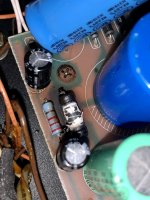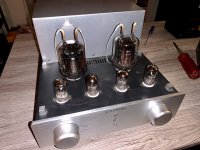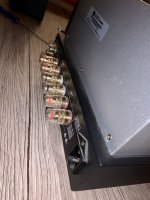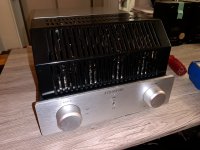I just got an Audioromy FU29 which was advertised by it's seller as being a SINGLE ENDED amp. I dug around in the thing and from my ohmmeter it sure looks like the 2 plates of the 829 are at opposite ends of the output transformer primary winding, with B+ fed to the tube via the center tap. That is a classic PUSH-PULL topology- NOT single ended!!!!!
Anybody here have any comment?
(It's a nice sounding amp, really, but it's advertised as SINGLE ENDED and it appears it is actually PUSH PULL!)
Anybody here have any comment?
(It's a nice sounding amp, really, but it's advertised as SINGLE ENDED and it appears it is actually PUSH PULL!)
Well, since this FU29 is not widely used, I would look up the datasheet to see how many watts would be expected from it in Single-Ended and Push-Pull Operation, and compare these with the advertised power output of the amplifier. I have never seen your amp, neither the datasheets, but from the look on it I can bet it makes 40-50 wpc in Push-Pull and about 12 wpc in Single Ended configuration.
In all, it is really not the end of the world. Just enjoy the greater power and efficiency. Don't even mention it to your friends it is a Push Pull amplifier if you feel you have been cheated. They will be impressed how strong 12 Single Ended watts are.I am sure it sounds pretty sweet as-is.
In all, it is really not the end of the world. Just enjoy the greater power and efficiency. Don't even mention it to your friends it is a Push Pull amplifier if you feel you have been cheated. They will be impressed how strong 12 Single Ended watts are.I am sure it sounds pretty sweet as-is.
Yep, it's push-pull
The folks selling these amps on eBay are now (mostly) listing them as PUSH-PULL, which they are.
They are not "ultralinear" as far as I can tell, no output transformer tap for the screen grid. Also, feedback seems minimal- so they have a distinctly "tubey" sound. Sounded great on a pair of bargain Polk RT25i speakers- the interaction between these speakers and the amp was kind of magical, I suspect it would be the same on many good 2-ways. It really made the little Polks sound warm and musical.
Build quality is not great, but it is "OK." Cosmetics are very good. Paired with the right speakers, it's a very musical ~25 watt/channel amp available for a very reasonable price.
The folks selling these amps on eBay are now (mostly) listing them as PUSH-PULL, which they are.
They are not "ultralinear" as far as I can tell, no output transformer tap for the screen grid. Also, feedback seems minimal- so they have a distinctly "tubey" sound. Sounded great on a pair of bargain Polk RT25i speakers- the interaction between these speakers and the amp was kind of magical, I suspect it would be the same on many good 2-ways. It really made the little Polks sound warm and musical.
Build quality is not great, but it is "OK." Cosmetics are very good. Paired with the right speakers, it's a very musical ~25 watt/channel amp available for a very reasonable price.
yep - the '29 is not a candidate for u/l since the g3 is common to both sections... 25wpc is a tad optimistic, but not horrifically so.
"Single terminal Class-A" - no idea what single terminal means, but I can understand that many people might assume it means single ended. Buying anything from China is a gamble, so only use money you can afford to lose or plan to rebuild it properly.
LOW FEEDBACK WILL RESULT IN LOWER POWER LEVELS>
Not really. The dynamic output impedance varies with feedback, but the max power that the tube is able to deliver per given load does not change.
I seem to recall seeing a schematic for this amp. Push pull, tetrode wired, cathode biased. You can squeeze more power out of these tubes but it requires a relatively lean bias to not exceed max plate dissipation. You give up quality for quantity.
The Audioromy amp is probably biased near its max plate dissipation in lean class A. Neither section reaches full cutoff, but it comes really close and the current conduction waveform of each section is highly asymmetrical (though most of this asymmetry cancels out by the time it reaches the output). It seems that back in the old days they would refer to this as a type of opperation as Class AB for cathode bias, but nowadays they teach if neither device cuts-off during part of the cycle; its class A. Either way, this type of operation is a good balance between power, quality and efficiency. 25W out seems about right to me for this tube. I bet with an audio signal it will put out 60W peaks.
Yes it's true that the tube's power capability is fixed, based on the tube design / construction. However, a lower feedback design will have more distortion as you ask the tube for more power- while a higher feedback design will let you push the tube harder. If you arbitrarily set 1% THD as the maximum allowable distortion level, the low NFB design will produce less power at that limit.
Here you can see that you can get about 3 watts at 8 ohms at 1% THD with high negative feedback, and less than 2 watts at 1% THD without NFB.
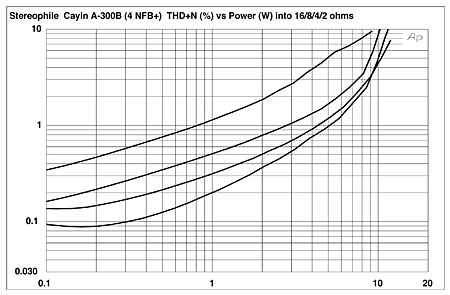
Cayin A-300B, 4 ohm tap, high negative feedback, distortion (%)vs 1kHz continuous output power into (from bottom to top at 1W): 16, 8, 4, 2 ohms, one channel driven.
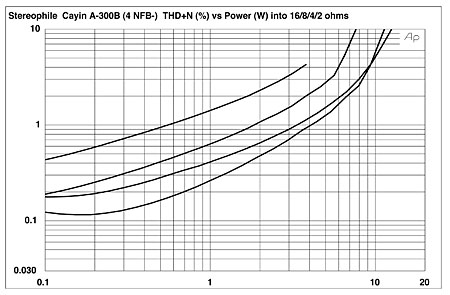
Fig.7 Cayin A-300B, 4 ohm tap, zero negative feedback, distortion (%)vs 1kHz continuous output power into (from bottom to top at 1W): 16, 8, 4, 2 ohms, one channel driven.
Here you can see that you can get about 3 watts at 8 ohms at 1% THD with high negative feedback, and less than 2 watts at 1% THD without NFB.

Cayin A-300B, 4 ohm tap, high negative feedback, distortion (%)vs 1kHz continuous output power into (from bottom to top at 1W): 16, 8, 4, 2 ohms, one channel driven.

Fig.7 Cayin A-300B, 4 ohm tap, zero negative feedback, distortion (%)vs 1kHz continuous output power into (from bottom to top at 1W): 16, 8, 4, 2 ohms, one channel driven.
Ok, you are correct if using the 1%THD rating for output power. I was reffering to maximum output (clipping).
Long term reliability Audioromy FU-29 amplifier
This amp has been in daily use for about 2 years now, filament on one 6N1 failed (opened) so replaced that tube.
Good reliability.
This amp has been in daily use for about 2 years now, filament on one 6N1 failed (opened) so replaced that tube.
Good reliability.
Further notes- Audioromy FU-29 amp
Another year of daily use. Another 6N1 input tube failed- filament not open but tube has no gain. Replaced it, these are cheap tubes, easily gotten.
The plate caps for the FU-29 (829) tube have turned brown and brittle, I replaced them with some ceramic ones.
Amp still working fine.
Note that mine is the original SILVER version. The Audioromy FU-29 being sold now has a gold color top plate on the chassis, and different driver tubes; is supposed to sound better.
Daily use for more than 4 years and it only needed 2 cheap 6N1 tubes, that is pretty good IMHO. Many people claim that all Chinese-made audio is cheap unreliable junk, but here we have an amp with very nice sound you can get for under $500 and that is quite reliable. Cheap junk would never run day in and day out for 4 years. I've had expensive tube amps die in 6 months. Higher price does not guaranty higher quality.
That said, this is not a perfect amp- not as transparent as many other good amps. But pair it with the right speaker and you get a little magic. This amp with the little Polk RT25i gave me very satisfying and musical sound for under $700. I liked this amp with the RT25i better than any other amp I tried with the little Polks. I am arranging to try the amp with some other little 2-way speakers, which are upmarket from the Polks. I'll report on that in a later post.
I tried the FU-29 on my Quad ESL-57's and the sound was OK, but the Quads want more power. I usually use a Citation II on the Quads, that sounds much better to me. The Audioromy with the ESL-57's had a kind of bloated bass. Likely too much interaction with the weird impedance of the ESL-57's.
Another year of daily use. Another 6N1 input tube failed- filament not open but tube has no gain. Replaced it, these are cheap tubes, easily gotten.
The plate caps for the FU-29 (829) tube have turned brown and brittle, I replaced them with some ceramic ones.
Amp still working fine.
Note that mine is the original SILVER version. The Audioromy FU-29 being sold now has a gold color top plate on the chassis, and different driver tubes; is supposed to sound better.
Daily use for more than 4 years and it only needed 2 cheap 6N1 tubes, that is pretty good IMHO. Many people claim that all Chinese-made audio is cheap unreliable junk, but here we have an amp with very nice sound you can get for under $500 and that is quite reliable. Cheap junk would never run day in and day out for 4 years. I've had expensive tube amps die in 6 months. Higher price does not guaranty higher quality.
That said, this is not a perfect amp- not as transparent as many other good amps. But pair it with the right speaker and you get a little magic. This amp with the little Polk RT25i gave me very satisfying and musical sound for under $700. I liked this amp with the RT25i better than any other amp I tried with the little Polks. I am arranging to try the amp with some other little 2-way speakers, which are upmarket from the Polks. I'll report on that in a later post.
I tried the FU-29 on my Quad ESL-57's and the sound was OK, but the Quads want more power. I usually use a Citation II on the Quads, that sounds much better to me. The Audioromy with the ESL-57's had a kind of bloated bass. Likely too much interaction with the weird impedance of the ESL-57's.
Hi I was wondering if you can help me. I have an early version of this amp. Someone gave it to me. They have no info. there are no markings for the preamp tubes. This is the silver top version with 4 preamp tubes in a straight line…the one with power transformer on one side and output transformers on the other…I just got an Audioromy FU29 which was advertised by it's seller as being a SINGLE ENDED amp. I dug around in the thing and from my ohmmeter it sure looks like the 2 plates of the 829 are at opposite ends of the output transformer primary winding, with B+ fed to the tube via the center tap. That is a classic PUSH-PULL topology- NOT single ended!!!!!
Anybody here have any comment?
(It's a nice sounding amp, really, but it's advertised as SINGLE ENDED and it appears it is actually PUSH PULL!)
Is there a schematic for this version ?
What is the tube preamp layout? This one needs repair. One side has some burn marks where a 10ohm ceramic resistor seems to have cracked on the power tube socket. It also has a large burnt resistor on the power supply board. Need to know the value.
Any help would be appreciated.
Thx.
Attachments
FWIW the FU-29 is more less an 829B / 3E29 (3E29 is an 829B modified to handle higher voltages in pulse modulator service).
The advantage that the FU29 has is that they're mostly new production from China, and haven't been sitting for 80 years (most 829Bs and 3E29s date back to WWII). Most of the NOS 829B and 3E29 tube I come across will not hold off their rated plate voltage and need a bit of "help" to clean up the vacuum before they're useable. I would not be the least bit surprised if the damage to the amp in the preceding post was caused by a tube arc.
The advantage that the FU29 has is that they're mostly new production from China, and haven't been sitting for 80 years (most 829Bs and 3E29s date back to WWII). Most of the NOS 829B and 3E29 tube I come across will not hold off their rated plate voltage and need a bit of "help" to clean up the vacuum before they're useable. I would not be the least bit surprised if the damage to the amp in the preceding post was caused by a tube arc.
For all such amplifiers, check how your amplifier is using those tubes (maximum ratings versus actual use).
These are not your average pair of 6L6GC, an 829B can be finicky.
829B Tube Maximum per tube (total of both beam power sections together)
Plate 30Watts (15 watts per plate)
Screen Voltage 225Volts
Screen dissipation 7 Watts (total, and the screens are connected together as one)
G1 Rg 100k Ohms, in some conditions must not exceed 15k Ohms
And the screen voltage often requires 32k Ohms in series from the voltage source (With that many Ohms of a series screen resistor, it must be bypassed to ground or the cathode, in order to keep the screen voltage constant with signal).
Violate one or more of these, and watch what happens.
All 829B tubes are created equal; but some 829B tubes are more equal than others.
These are not your average pair of 6L6GC, an 829B can be finicky.
829B Tube Maximum per tube (total of both beam power sections together)
Plate 30Watts (15 watts per plate)
Screen Voltage 225Volts
Screen dissipation 7 Watts (total, and the screens are connected together as one)
G1 Rg 100k Ohms, in some conditions must not exceed 15k Ohms
And the screen voltage often requires 32k Ohms in series from the voltage source (With that many Ohms of a series screen resistor, it must be bypassed to ground or the cathode, in order to keep the screen voltage constant with signal).
Violate one or more of these, and watch what happens.
All 829B tubes are created equal; but some 829B tubes are more equal than others.
Last edited:
- Home
- Amplifiers
- Tubes / Valves
- Audioromy FU-29 - push pull!
